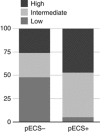SERPINE1 and SMA expression at the invasive front predict extracapsular spread and survival in oral squamous cell carcinoma
- PMID: 25268377
- PMCID: PMC4260028
- DOI: 10.1038/bjc.2014.500
SERPINE1 and SMA expression at the invasive front predict extracapsular spread and survival in oral squamous cell carcinoma
Abstract
Background: Extracapsular spread (ECS) in cervical lymph nodes is the single-most prognostic clinical variable in oral squamous cell carcinoma (OSCC), but diagnosis is possible only after histopathological examination. A promising biomarker in the primary tumour, alpha smooth muscle actin (SMA) has been shown to be highly prognostic, however, validated biomarkers to predict ECS prior to primary treatment are not yet available.
Methods: In 102 OSCC cases, conventional imaging was compared with pTNM staging. SERPINE1, identified from expression microarray of primary tumours as a potential biomarker for ECS, was validated through mRNA expression, and by immunohistochemistry (IHC) on a tissue microarray from the same cohort. Similarly, expression of SMA was also compared with its association with ECS and survival. Expression was analysed separately in the tumour centre and advancing front; and prognostic capability determined using Kaplan-Meier survival analysis.
Results: Immunohistochemistry indicated that both SERPINE1 and SMA expression at the tumour-advancing front were significantly associated with ECS (P<0.001). ECS was associated with expression of either or both proteins in all cases. SMA+/SERPINE1+ expression in combination was highly significantly associated with poor survival (P<0.001). MRI showed poor sensitivity for detection of nodal metastasis (56%) and ECS (7%). Both separately, and in combination, SERPINE1 and SMA were superior to MRI for the detection of ECS (sensitivity: SERPINE1: 95%; SMA: 82%; combination: 81%).
Conclusion: A combination of SMA and SERPINE1 IHC offer potential as prognostic biomarkers in OSCC. Our findings suggest that biomarkers at the invasive front are likely to be necessary in prediction of ECS or in therapeutic stratification.
Figures





Similar articles
-
Extracapsular spread in oral squamous cell carcinoma.Head Neck. 2010 Jun;32(6):714-22. doi: 10.1002/hed.21244. Head Neck. 2010. PMID: 19827119
-
Evaluation of the level of progression of extracapsular spread for cervical lymph node metastasis in oral squamous cell carcinoma.Int J Oral Maxillofac Surg. 2016 Feb;45(2):141-6. doi: 10.1016/j.ijom.2015.09.005. Epub 2015 Oct 2. Int J Oral Maxillofac Surg. 2016. PMID: 26439759
-
Epidermal growth factor receptor gene copy number aberration at the primary tumour is significantly associated with extracapsular spread in oral cancer.Br J Cancer. 2011 Mar 1;104(5):850-5. doi: 10.1038/bjc.2011.22. Epub 2011 Feb 8. Br J Cancer. 2011. PMID: 21304522 Free PMC article.
-
Progression level of extracapsular spread and tumor budding for cervical lymph node metastasis of OSCC.Clin Oral Investig. 2018 Apr;22(3):1311-1318. doi: 10.1007/s00784-017-2231-y. Epub 2017 Oct 6. Clin Oral Investig. 2018. PMID: 28986696
-
Small size of metastatic lymph nodes with extracapsular spread greatly impacts treatment outcomes in oral squamous cell carcinoma patients.Int J Oral Maxillofac Surg. 2018 Jul;47(7):830-835. doi: 10.1016/j.ijom.2017.12.007. Epub 2018 Jan 17. Int J Oral Maxillofac Surg. 2018. PMID: 29373201
Cited by
-
Prioritization of genes involved in endothelial cell apoptosis by their implication in lymphedema using an analysis of associative gene networks with ANDSystem.BMC Med Genomics. 2019 Mar 13;12(Suppl 2):47. doi: 10.1186/s12920-019-0492-9. BMC Med Genomics. 2019. PMID: 30871556 Free PMC article.
-
Diagnostic challenges and prognostic implications of extranodal extension in head and neck cancer: a state of the art review and gap analysis.Front Oncol. 2023 Sep 20;13:1263347. doi: 10.3389/fonc.2023.1263347. eCollection 2023. Front Oncol. 2023. PMID: 37799466 Free PMC article. Review.
-
MMP14 expression levels accurately predict the presence of extranodal extensions in oral squamous cell carcinoma: a retrospective cohort study.BMC Cancer. 2023 Feb 10;23(1):142. doi: 10.1186/s12885-023-10595-x. BMC Cancer. 2023. PMID: 36765296 Free PMC article.
-
Prediction of prognosis in oral squamous cell carcinoma using infrared microspectroscopy.Cancer Med. 2024 Mar;13(5):e7094. doi: 10.1002/cam4.7094. Cancer Med. 2024. PMID: 38468595 Free PMC article.
-
Biomarkers: paving stones on the road towards the personalized precision medicine for oral squamous cell carcinoma.BMC Cancer. 2018 Sep 21;18(1):911. doi: 10.1186/s12885-018-4806-7. BMC Cancer. 2018. PMID: 30241505 Free PMC article. Review.
References
-
- Alvi A, Johnson JT. Extracapsular spread in the clinically negative neck (N0): implications and outcome. Otolaryngol Head Neck Surg. 1996;114 (1:65–70. - PubMed
-
- Baker EA, Leaper DJ, Hayter JP, Dickenson AJ. Plasminogen activator system in oral squamous cell carcinoma. Br J Oral Maxillofac Surg. 2007;45 (8:623–627. - PubMed
-
- Barry CP, Katre C, Papa E, Brown JS, Shaw RJ, Bekiroglu F, Lowe D, Rogers SN. De-escalation of surgery for early oral cancer—is it oncologically safe. Br J Oral Maxillofac Surg. 2013;51 (1:30–36. - PubMed
-
- Bryne M, Koppang HS, Lilleng R, Kjaerheim A. Malignancy grading of the deep invasive margins of oral squamous cell carcinomas has high prognostic value. J Pathol. 1992;166 (4:375–381. - PubMed
Publication types
MeSH terms
Substances
LinkOut - more resources
Full Text Sources
Other Literature Sources
Medical
Miscellaneous

